- Home
- Richard Preston
The Demon in the Freezer Page 2
The Demon in the Freezer Read online
Page 2
Soon after the Capitol Police got the call from the woman in Senator Daschle’s office, a team of HMRU agents was dispatched from Quantico. The Capitol Police had sealed off the senator’s office. The HMRU team put on Tyvek protective suits, with masks and respirators, retrieved the letter from the wastebasket, and did a rapid test for anthrax—they stirred a little bit of the powder into a test tube. It came up positive, though the test is not particularly reliable. This was a forensic investigation of a crime scene, so the team members did forensic triage. They wrapped the envelope and the letter in sheets of aluminum foil, put them in Ziploc bags, and put evidence labels on the bags. They cut out a piece of the carpet with a utility knife. They put all the evidence into white plastic containers. Each container was marked with the biohazard symbol and was sealed across the top with a strip of red evidence tape. In the early afternoon, two special agents from the HMRU put the containers in the trunk of an unmarked Bureau car and drove north out of Washington and along the Beltway. They turned northwest on Interstate 270, heading for Fort Detrick, outside Frederick, Maryland.
Traffic is always bad on Interstate 270, but the HMRU agents resisted the temptation to weave around cars, and they went with the flow. It was hot and thunderstormy, too warm for October. Interstate 270 proceeds through rolling piedmont. The route is known as the Maryland Biotechnology Corridor, and it is lined with dozens of biotech firms and research institutes dealing with the life sciences. The biotech companies are housed in buildings of modest size, often covered with darkened or mirrored glass, and they are mixed in among office parks.
The office parks thinned out beyond Gaithersburg, and the land opened into farms broken by stands of brown hickory and yellow ash. White farmhouses gleamed among fields of corn drying on the stalk. Catoctin Mountain appeared on the horizon, a low wave of the Appalachians, streaked with rust and gold. The car arrived at the main gate of Fort Detrick, where an Abrams tank was parked with its barrel aimed toward downtown Frederick. A little more than a month after September 11th, Fort Detrick remained in a condition of Delta Alert, which is the highest level of alert save for when an attack is in progress. There were more guards than usual, and they were conspicuously armed with M16s and were searching all vehicles, but the HMRU car went through without a search.
The agents drove past the parade ground and parked in a lot that faces the United States Army Medical Research Institute of Infectious Diseases, or USAMRIID, the principal biodefense laboratory in the United States. USAMRIID is pronounced “you-sam-rid,” but many people call it simply Rid, or they refer to it as the Institute. USAMRIID’s mission is to develop defenses against biological weapons, both medicines and methods, and to help protect the population against a terrorist attack with a biological weapon. USAMRIID sometimes performs work for outside “clients”—that is, other agencies of the U.S. government. Fort Detrick was the center of the Army’s germ weapons research and development until 1969, when President Richard Nixon shut down all American offensive biowarfare programs. Three years later, the United States signed the Biological Weapons and Toxin Convention, or BWC, which bans the development, possession, or use of biological weapons. The BWC has been signed by more than one hundred and forty nations, some of which are observing the treaty while others are not.
The main building of USAMRIID is a dun-colored, two-story monolith that looks like a warehouse. It has virtually no windows, and tubular chimneys sprout from its roof. The building covers seven acres of ground. There are biocontainment suites near the center of the building—groups of laboratory rooms that are sealed off and kept under negative air pressure so that nothing contagious will leak out. The suites are classified at differing levels of biosecurity, from Biosafety Level 2 to Level 3 and finally to Level 4, which is the highest, and where scientists wearing biosafety space suits work with hot agents—lethal, incurable viruses. (A bioprotective space suit is a pressurized plastic suit that covers the entire body. It has a soft plastic head-bubble with a clear faceplate, and it is fed by sterile air coming through a hose and an air regulator.) The chimneys of the building are always exhausting superfiltered and superheated sterilized air, which is drawn out of the biocontainment zones. USAMRIID was now surrounded by concrete barriers, to prevent a truck bomb from cracking open a Biosafety Level 4 suite and releasing a hot agent into the air.
The HMRU agents opened the trunk of their car, took out the biohazard containers, and carried them across the parking lot into USAMRIID. In a small front lobby, the agents were met by a civilian microbiologist named John Ezzell. Ezzell is a tall, rangy, intense man, with curly gray hair and a full beard. FBI people who know him like to remark on the fact that Ezzell drives a Harley-Davidson motorcycle; they like his style. John Ezzell has been the anthrax specialist for the FBI’s Hazardous Materials Response Unit since 1996, when the unit was formed. Over the years, he has analyzed hundreds of samples of putative anthrax collected by the HMRU. The samples had all proven to be hoaxes or incompetent attempts to make anthrax—slime, baby powder, dirt, you name it. When Ezzell was analyzing samples for the HMRU, he would often live in the USAMRIID building, sleeping on a folding cot near his lab.The agents had brought him many samples before—there had been many anthrax threats in the past. The FBI had become an important client of USAMRIID.
They went through some security doors, turned down a corridor that had green cinder-block walls, and stopped in front of the entry door to suite AA3, a group of laboratory rooms kept at Biosafety Level 3, where Ezzell worked. The agents formally transferred the containers to USAMRIID, and they gave Ezzell some chain-of-custody forms, or “green sheets,” which had to be kept with the evidence, in case it was used in a trial.
Ezzell carried the containers into a small changing room at the entrance of the suite. He stripped down to his skin and put on green surgical scrubs but no underwear. He put on surgical gloves and sneakers and booties, he gowned up, and he fitted a respirator over his nose and mouth. Ezzell has been immunized to anthrax—all laboratory workers at Rid get booster shots once a year against anthrax. He carried the containers into a warren of labs in suite AA3 and placed them inside a laminar-flow hood—a glass safety cabinet with an open front in which the air is pulled up and away from a sample, preventing contamination.
Ezzell broke the evidence tape, opened the containers and the bags, and carefully unwrapped the aluminum foil. A silky-smooth, pale tan powder started coming off the foil and floating into the air, and up into the hood. The envelope inside one foil packet contained about two grams of the powder—enough to fill one or two sugar packets. It was postmarked Trenton, New Jersey, October 9th.
He opened the other foil packet, which contained the letter that had been inside the envelope. It was covered with words written in block capitals:
09-11-01
YOU CAN NOT STOP US.
WE HAVE THIS ANTHRAX.
YOU DIE NOW.
ARE YOU AFRAID?
DEATH TO AMERICA.
DEATH TO ISRAEL.
ALLAH IS GREAT.
John Ezzell took up a metal spatula—a sort of metal knife—and slid it very slowly inside the envelope. He took up a small amount of the powder on the tip of the spatula, lifted it out, and held it up inside the hood. He wanted to get the powder into a test tube, but it started flying off the spatula, the particles dancing up and away into the hood, pulled by the current of air in the hood. The powder had a pale, uniform, light tan color. It had tested positive in the rapid field test for anthrax, and it had the appearance of a biological weapon. “Oh, my God,” Ezzell said aloud, staring at the particles flying off his knife.
National Security
OCTOBER 16, 2001
IN THE EARLY HOURS of the day after the anthrax-laden letter was opened in Tom Daschle’s office, Peter Jahrling, the senior scientist at USAMRIID, was awakened by the sound of his pager. Jahrling (his name is pronounced “Jar-ling”) lives in a small, split-level house in an outer suburb of Washington. The house is yellow
and has a picket fence around it. Jahrling’s wife, Daria, was asleep beside him, and their children were asleep in their rooms—two daughters, Kira and Bria, and a son named Jordan, whom Peter calls the Karate Kid because Jordan is a black-belt champion. Their oldest child, a daughter named Yara, had left for college earlier that fall.
Jahrling looked at his watch: four o’clock. He put on his glasses, and, wearing only Jockey shorts, he walked down a short hallway into the kitchen, where his pager was sitting on the counter. It indicated that the call had come from the commander’s office at USAMRIID—from Colonel Edward M. Eitzen, Jr.
Jahrling called him back. “Hey, Ed, this is Peter. What’s up?”
Eitzen had been awake all night. “I want you to come into the office right now.” Some issues, he said, had arisen relative to the Institute’s characterization of the “sample.” He was being vague. “There’s highly placed interest in the sample.”
Jahrling realized that the sample in question was the anthrax letter that had been delivered to USAMRIID by the FBI the previous afternoon. He figured Eitzen meant that the White House had become involved, but wasn’t going to say so on an open phone line. It sounded like the National Security Council of the White House had activated emergency operations.
Jahrling returned to the bedroom and dressed quickly. He put on a light gray suit that looked like it came from Sears, Roebuck, a blue and white candy-striped shirt, and a jazzy black-and-white necktie. He fitted a silver tie bar over his tie, put on brown shoes, and hung the chain holding his federal ID card around his neck.
Peter Jahrling has a craggy face, and he wears Photogray glasses with metal rims. His hair was once yellow-blond, but it is now mostly gray. When he was younger, some of his colleagues at the Institute called him “The Golden Boy of USAMRIID” because of his blond hair and his apparent luck in making interesting discoveries about lethal viruses. He has an angular way of moving his arms and legs, a gawky posture, and it gives him the look of a science geek. It is a look he has had since he was a boy. He grew up an only child, and became fascinated with microscopes and biology at a young age. He thinks of himself as shy and socially awkward, although others think of him as blunt and outspoken, and sometimes abrasive.
Jahrling got into his car—a red Mustang with the license plate LASSA 3. His scientific interest is viruses that make people bleed—hem-orrhagic fever viruses—and among them is one called Lassa, a West African virus that Jahrling studied early in his career. (He uses LASSA 1, a bashed, corroded Pontiac with a vinyl roof that’s shredding away in strips, for long-distance drives, because he likes its soft seats and its boatlike ride. Daria drives LASSA 2, a Jeep.) He backed out of the driveway and drove fast along exurban roads through a beautiful night. The moon was down, and the air felt like summer, though the belt of Orion, a constellation of winter, blazed in the south. He was at the Institute by five o’clock. The place was usually dead at this hour, but the letter to Congress with some powder in it had kept people in the building overnight. He went to Colonel Eitzen’s office and sat down at a conference table. Ed Eitzen is a medical doctor with thinning brown hair and a square face, eyeglasses, and a straightforward, low-key way about him. He was dressed in a pale green shirt with silver oak leaves on the shoulder bars, and he was looking tense. He is a well-known expert in medical biodefense. He had delivered speeches at conferences on how to plan for bioterrorism; this was the real thing.
At FBI headquarters in the J. Edgar Hoover Building on Pennsylvania Avenue in Washington, the FBI’s emergency operations center, known as the SIOC (the Strategic Information Operations Center), was up and running. The SIOC is a wedge-shaped complex of rooms on the fifth floor of the headquarters, surrounded by layers of copper to keep it secure against radio eavesdropping. Desks are arrayed around a huge wall of video displays, which are updated in real time. The FBI had initiated around-the-clock SIOC operations on September 11th, and now a number of desks at the center had been devoted to the anthrax attacks. Agents from the FBI’s Weapons of Mass Destruction Operations Unit were stationed at the SIOC. They had set up a live videoconference link with a crisis operations center at the National Security Council. The NSC operations center is in the Old Executive Office Building, across the street from the White House. An NSC official named Lisa Gordon-Hagerty was there and running things. The federal government had gone live.
Colonel Eitzen had been hooked into the SIOC and the NSC op center all night, while John Ezzell phoned him from his lab with the results of tests he was doing on the anthrax. Since his “Oh, my God,” Ezzell had been working furiously, trying to get a sense of what kind of a weapon it was. He wasn’t going to be sleeping on his cot during this terror event; he wouldn’t sleep anytime soon. Meanwhile, the White House people were spinning over the word weapon. They wanted to know what, exactly, the USAMRIID scientists meant by the terms weapon and weapons-grade, and they wanted answers fast. What is “weapons-grade” anthrax? Had the Senate been hit with a weapon?
Jahrling and Eitzen discussed what USAMRIID should say. The White House was USAMRIID’s most important client. Eitzen felt that the Institute should steer away from using the words weapon or weaponized until more was known about the powder. Jahrling agreed with him, and together they came up with the words professional and energetic to describe it, and they decided to take back the word weapon, which was making people too nervous.
Eitzen called the national-security people to discuss the adjustment of thinking. He used an encrypted telephone—a secure telephonic unit, or STU (pronounced “stew”) phone. A stew phone makes you sound like Donald Duck eating sushi. Eitzen said, “I’m going secure.” Then, speaking slowly, he told the national-security people and the FBI what John Ezzell was learning about the anthrax.
AT SIX O’CLOCK that morning, Peter Jahrling went into his office to check his e-mail. Jahrling’s office is small and windowless, and is decorated with heaps of paper along with memorabilia from his travels—a license plate from Guatemala, where he once worked as a virus hunter; a carved wooden cat; a map of Africa showing the types of vegetation on the continent; a metal telephone, with a speaking horn, that he picked up at Vector, the Russian State Research Center of Virology and Biotechnology, in Siberia. In the nineteen eighties and early nineties, the Soviets had carried out all kinds of secret work on virus weapons at Vector. The metal telephone once sat inside a clandestine Level 4 biocontainment lab; you could shout into the speaking horn while you were wearing a protective space suit—to call for help during an emergency with a military strain of smallpox, perhaps. Jahrling had been to Vector many times. He worked in the Cooperative Threat Reduction Program, which gave money to former Soviet bioweaponeers in the hope of encouraging them to do peaceful research, so they wouldn’t sell their expertise to countries such as Iran and Iraq.
Jahrling sat down at his desk and sighed. There was a landfill of papers on his desk, mostly about smallpox, and it was discouraging. On top of the heap sat a large red book with silver lettering on its cover: Smallpox and Its Eradication. The experts in poxviruses call it the Big Red Book, and it was supposed to be the last word on smallpox, or variola, which is the scientific name of the smallpox virus. The authors of the Big Red Book had led the World Health Organization campaign to eradicate smallpox from the face of the earth, and on December 9, 1979, their efforts were officially certified a success. The disease no longer existed in nature. Doctors generally consider smallpox to be the worst human disease. It is thought to have killed more people than any other infectious pathogen, including the Black Death of the Middle Ages. Epidemiologists think that smallpox killed roughly one billion people during its last hundred years of activity on earth.
Jahrling kept the Big Red Book sitting on top of his smallpox papers, where he could reach for it in a hurry. He reached for it practically every day. For the last two years, Jahrling had run a program that was attempting to open the way for new drugs and vaccines that could cure or prevent smallpox. Scientifically, he wa
s more deeply involved with smallpox than anyone else in the world, and he regarded smallpox as the greatest biological threat to human safety. Officially, the smallpox virus exists in only two repositories: in freezers in a building called Corpus 6 at Vector in Siberia, and in a freezer in a building called the Maximum Containment Laboratory at the Centers for Disease Control in Atlanta. But, as Peter Jahrling often says, “If you believe smallpox is sitting in only two freezers, I have a bridge for you to buy. The genie is out of the lamp.”
Peter Jahrling has a high-level national-security clearance known as codeword clearance, or SCI clearance, which stands for Sensitive Compartmentalized Information. Access to SCI, which is sometimes termed ORCON information (“originator controlled”), is available through code words. If you have been cleared for the ORCON code word, you can see the information. The information is written on a document that has red-slashed borders. You look at the information inside a secure room, and you cannot walk out of the room with anything except the memory of what you’ve seen.
Around the corner from Jahrling’s office is a room known as the Secure Room, which is always kept locked. Inside it there is a stew phone, a secure fax machine, and several safes with combination locks. Inside the safes are sheets of paper in folders. The sheets contain formulas for biological weapons. Some of the weapons may be Soviet, some possibly may be Iraqi, and a number of the formulas are American and were developed at Fort Detrick in the nineteen sixties, before offensive bioweapons research in the United States was banned. When the old biowarfare program was at its peak, an Army scientist named William C. Patrick III led a team that developed a powerful version of weaponized anthrax. Patrick held several classified patents on bioweapons.
There is probably a piece of paper sitting in the classified safe at USAMRIID—I have no way of knowing this for certain—containing a list of the nations and groups that the CIA believes either have clandestine stocks of smallpox or are trying actively to get the virus. At the top of the list would be the Russian Federation, which seems to have secret military labs working on smallpox weapons today. The list would also likely include India, Pakistan, China, Israel (which has never signed the Biological Weapons and Toxin Convention), Iraq, North Korea, Iran, the former Yugoslavia, perhaps Cuba, perhaps Taiwan, and possibly France. Some of those counties may be doing genetic engineering on smallpox. Al-Qaeda would be on the list, as well as Aum Shinrikyo, a Japanese religious cult that released sarin nerve gas in the Tokyo subway system. There is most likely a fair amount of smallpox loose in the world. The fact is that nobody knows where all of it is or what, exactly, people intend to do with it.

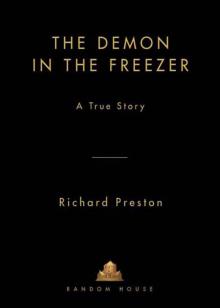 The Demon in the Freezer
The Demon in the Freezer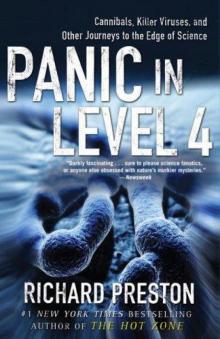 Panic in Level 4: Cannibals, Killer Viruses, and Other Journeys to the Edge of Science
Panic in Level 4: Cannibals, Killer Viruses, and Other Journeys to the Edge of Science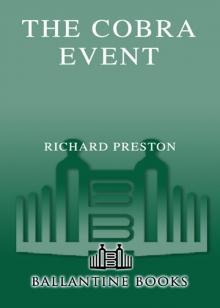 The Cobra Event
The Cobra Event The Hot Zone
The Hot Zone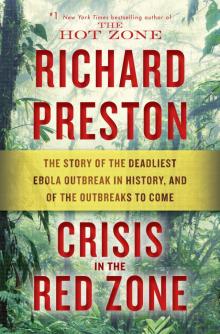 Crisis in the Red Zone
Crisis in the Red Zone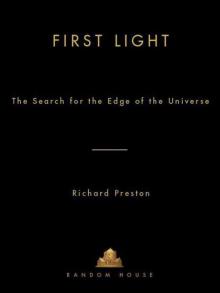 First Light: The Search for the Edge of the Universe
First Light: The Search for the Edge of the Universe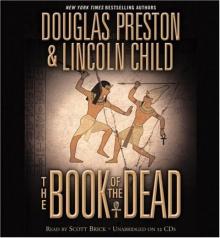 The Book of the Dead
The Book of the Dead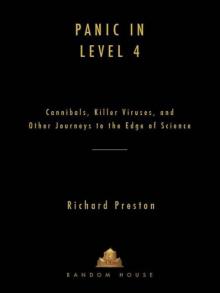 Panic in Level 4
Panic in Level 4